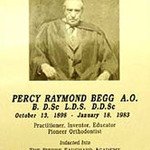Percy Raymond Begg
Adeliade, Australia — 1898-1983
Practitioner, Inventor, Educator, Pioneer Orthodontist
Dr. Percy Raymond Begg was born in a tent in the goldfields of Coolgardie, Western Australia, on 13th October 1898, the son of accountant and business manager Percy William Begg and his wife Fannie Elizabeth (nee Jacob). In 1900 the family moved to Adelaide and Begg attended Pulteney Grammar School and St. Peter’s College, where he was a classmate of Nobel Prize winner, Howard Florey (q.v.). In 1923 he received his Bachelor of Dental Science from the University of Melbourne and then spent two years at the Angle School of Orthodontia in Pasadena, California, under Dr. Edward Angle, who is remembered as the father of modern orthodontia.
Armed with the “latest and best” in orthodontic appliances, Dr. Begg sailed home to Australia and commenced orthodontic practice in Adelaide. He was the only orthodontist in Adelaide until 195 1. In January 1929 he began teaching orthodontics, simultaneously holding the positions of Honorary Dental Surgeon at the Adelaide Hospital and Lecturer in Orthodontics at the University of Adelaide. On 26th April 1928 he married Evelyn Ellen (Nellie) Hamilton and they had three children.
For 2 years Dr. Begg faithfully followed Dr. Angle’s teaching of retaining the full complement of teeth. However, he was confronted with evidence of serious relapse in many of his patients. Dr. Begg began the routine removal of teeth in February 1928, as the result of his now well-known studies of Stone Age Man’s attritional occlusion of the teeth.
Tick Begg was a dedicated clinician who had an extraordinary memory and a vision of orthodontics which stamped him as a man in advance of his times. The problems he encountered when using the edgewise appliance to close extraction spaces and to reduce deep anterior overbites prompted the evolution of the Begg technique over the following 20 years. In 1920 he began using round arch wire. By 1933 he stopped using edgewise brackets and began to use Dr. Angle’s ribbon arch bracket with the openings of the slots facing gingivally, rather than incisally and occlusally as Dr. Angle advocated. During 1934 Dr. Begg treated his first planned eight-tooth extraction case with removal of the four first premolars and the four first permanent molars. The spring quality of the round stainless steel wire then available was a great improvement over rectangle gold-platinum wire. Early in the 1940’s Dr. Begg became acquainted with Arthur Wilcock, a metallurgist from Melbourne. After years of collaboration with Dr. Begg, Mr. Wilcock finally produced a unique stainless steel wire that combined particular features of hardness and resilience. It is not generally known, but well documented,, that in 1954 in association with Mr. Wilcock and Professor J.N. Greenwood, the Research Professor of Metallurgy, Dr. Begg employed titanium wire for the treatment of his patients. During the following 29 years a continuing series of technical and clinical innovations were demonstrated to the profession. Orthodontics was his consuming interest. In December 1982, during his eighty-four year, he registered his last patent and was still preparing publications.
Dr. Begg’s first publication in 1926 and subsequent articles reflected his interest in normal occlusion and etiology of malocclusion. A Doctorate of Dental Science from the University of Adelaide was conferred on him in 1935. The title of his dissertation was Some Aspects of the Etiology ofirregularity and Malocclusion of the Teeth. The series of articles on “Stone Age Man’s Dentition” and the “Light Arch Wire Technique” which appeared in the AMERICAN JOURNAL OF ORTHODONTICS during 1954 and 1956 established him as an orthodontist of international renown. Three editions of the textbook Begg Orthodontic Theory and Technique have been translated into five languages.
A permanent display of the Begg technique is in the Smithsonian Institution (Washington, D.C.) and also in the Library of the American Dental Association in Chicago, Illinois.
The Adelaide Dental Hospital on Frome Road is the site of the Begg Memorial, an exhibition of his surgery equipment, appliances and patient records.
Dr. Begg was a founding member of the Australian Society of Orthodontists in 1927. The American Association of Orthodontists honoured Dr. Begg in 1977 with the Albert H. Ketcham Memorial Award. For distinguished service of a high degree to Australia and to humanity at large, the Australian Government conferred upon him the award of Officer of the Order of Australia (A.0.) in June 198 1.
Percy Raymond Begg was a brilliant orthodontist who discovered a unique method of moving teeth. He provided many thousands of children and adults with amazing corrections of their dental and facial deformities and these benefits continue to be experienced by patients all over the world because of Begg’s willingness to share his knowledge.
It is an hon our to present the first Distinguished Australian Dentist for Induction into the Pierre Fauchard Academy International Hall of Fame of Dentistry.



